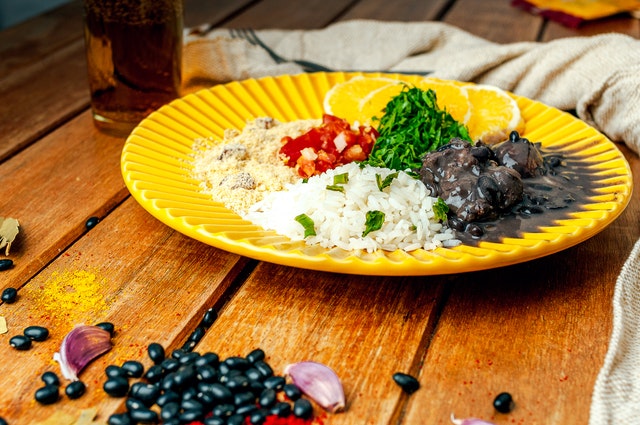Yesterday afternoon as I was stirring a pot of fragrant black beans, the main course for our afternoon meal (I still don’t know if I should call it late lunch or early dinner) I realized that despite the fact that I have now lived in Spain for over six months, I am still cooking like an immigrant. In other words, I am still preparing meals and feeding my family with the flavors I know from home.
Coming to Spain to Eat Like a Spaniard

The thing is, I really love Spanish food, but it took me a while to actually say that and mean it. The reason being, is that the first time I lived in Spain – back when I was in college – my experience with Spanish cuisine was pretty dismal. First of all, I was living in land-locked Salamanca, which meant no fresh fish or seafood. Second of all, I was living with a “host family” that was really more like a boarding house for foreign students. And our “host mother” was a horrible cook, who had the habit of over salting her food whenever she was mad or distressed, which sadly, was often. In addition, she didn’t have an oven, so her cooking technique of choice was to deep fry everything in her counter-top fryer. Dear readers, I cried many times at the dinner table.
But once I met el esposo and traveled south and sampled the food that was heavily influenced by the ocean and Northern Africa, and I tasted the food lovingly prepared by el esposo’s mother, my opinions changed. Drastically. Not only was Spanish cuisine delicious, but it was also far more varied than the bean stews and fried green peppers I’d been exposed to in Salamanca. (side note: I have since come to love fried green peppers.) Every region of Spain has its own unique flavors and dishes that deserve praise and adoration. So, when we decided to move here and make our home here, I assumed I would simply adopt and adapt to Spanish culinary culture and start feeding my family healthy, delicious Spanish meals.
Just Because The Ingredients are Available Doesn’t Mean I Know What To Do with Them
So, one of my favorite things to do here in Spain is to go to the market. And where we live, there are many. There’s the big one in the city, that offers a dizzying array of fruits, vegetables, spices, fish, meats and cheeses. And then there are mini versions of that market within walking distance of my apartment. On Saturdays, a market opens up along the beach. I love taking my cart and just staring at all of the gorgeous produce -some I recognize and some that are completely new to me. Sometimes I ask the vendors what to do with a vegetable I’ve never seen before, sometimes I buy them and tell myself I’ll figure it out when I get home. B
And that’s just it, I can buy all the same ingredients that the Spaniards buy, but when I take them home, I’m cooking like an “American.” I prepare acelgas like collard greens. I turn squash and pumpkin into soup. I found this vegetable that looked like a cross between a cauliflower and a broccoli, so I roasted it like a cauliflower, but it was too bitter for my taste. I probably won’t buy it again.
Cooking Like an Immigrant is an Act of Survival
As I was making my black beans yesterday, substituting smoked paprika for the chili powder I cannot find here in Spain, I realized that for all of my professed love of Spanish cuisine, I’m still resorting to the comfort of my familiar in the kitchen. I did buy a Spanish cookbook, and I keep promising myself I’m going to sign up for cooking classes, but in the meantime, I’m making what I know. And in so doing, I realized I was joining the long line of immigrants who come to a new country and hold on to their culture through their cooking. I once thought that was a willful act, a decision not to assimilate. But now I realize that cooking what you know, can simply be an act of survival. A decision based strictly on what you know how to do and not wanting to, or being able to, take the time to learn an entirely new way of preparing and eating food. That’s a very heavy lift.
As much as I love Spanish food, just the thought of figuring out how to make my favorite dishes is overwhelming and comes in at about number 67 on my Assimilate-to-a-New-Country To-Do List.
I think that’s why God invented restaurants and mothers-in-laws.
Permission Granted to Cook and Eat Like an Immigrant
Here’s the thing. The food I used to make in the United States cannot be categorized as “American food,” whatever that means. I was already a meltingpot alchemist in the kitchen. I took inspiration from all of the different ethnic cuisines I’d sampled and loved, blended that with my own African-American culinary upbringing and created something unique. In my house you’d be likely to eat Jamaican curry chicken one day, pasta with pesto the next, and tacos every Friday. On New Year’s Day you most definitely would have pork, black-eyed peas, collard greens and corn bread. During the pandemic, I learned how to make proper potato salad. Here in Spain, I continue to make these familiar dishes that speak to my love of global flavors. And I’m sure the longer we live here, the more I will incorporate Spanish flavors into my repertoire, but for now, I’m giving myself permission to cook and eat like an immigrant. Because that’s what I am.
For those of you who have moved abroad, what flavors and dishes dominate in your kitchen? For those of you children of immigrants (and migrants), what flavors “from home” do you continue to make?

